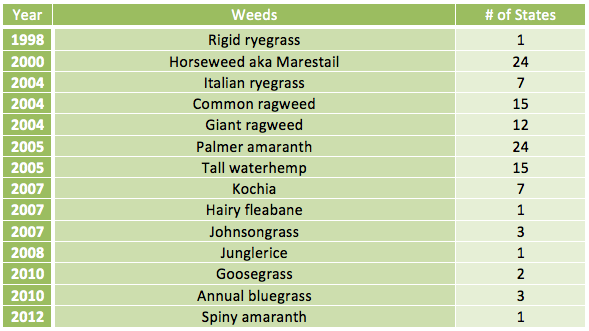Russell R. Hahn, School of Integrative Plant Science, Soil and Crop Sciences Section, Cornell University
The number of herbicide resistant weed biotypes has increased from 404 to 437 in the past 12 months. A summary of resistant biotypes for various herbicide site-of-action groups is shown in Table 1. There have been 13 new cases of ALS (acetolactate synthase) inhibitor resistance (Group 2 herbicides) and 7 new cases of glyphosate (EPSP inhibitor) resistance (Group 9 herbicides) around the World during the past year. Along with these newly documented cases of herbicide resistance, there continues to be much media attention to this problem, especially related to glyphosate-resistant (GR) weeds.

WSSA Takes Action
In response to the growing concern about herbicide resistance, the Weed Science Society of America (WSSA) sponsored a national scientific summit on this topic September 10, 2014 in Washington D.C. This summit built on the insights and perspectives developed at a similar event in 2012. Dr. David Shaw, a past president of WSSA and Chair of the WSSA Herbicide Resistance Education Committee said “We want everyone to walk away with a clear understanding of specific actions they can take to help minimize the devastating impact of herbicide resistance on agricultural productivity”. In Addition, WSSA issued a new fact sheet to address the media attention/hysteria about herbicide resistance on October 8, 2014. The fact sheet discusses the truth behind two common misconceptions about “superweeds”. According to WSSA, the first misconception is that “superweeds” are the product of rampant gene transfer from genetically modified crops creating herbicide resistant weeds. The second misconception is that “superweeds” have supercharged abilities to muscle out competing plants in new and more aggressive ways”. The WSSA fact sheet is posted online at http://wssa.net/weed/wssa-fact-sheets.
Glyphosate-Resistant Weeds
While ALS inhibitor-resistant weeds account for one-third of the documented cases, GR weeds get more attention because of the connection to the vast acreages of GR crops and because of the rapid spread of GR Palmer amaranth across the U.S. A summary of GR weeds in the U.S. is shown in Table 2.

Although there are no documented cases of GR weeds in NY, it’s likely that there are isolated GR weed populations in the state. Several years ago, there was a situation in western NY where a grower noticed giant ragweed that had not been controlled with a normal glyphosate application in soybeans on newly purchased land. The previous landowner had purchased a combine from Ohio where there have been documented cases of GR giant ragweed. Seed from the surviving giant ragweed were grown in the greenhouse and treated at 3 or 6 inches in height with from 22 to 88 fl oz/A of Roundup PowerMax. Some of the 3- and 6-inch giant ragweed survived up to 88 fl oz/A of Roundup PowerMax. There are also reports of horseweed (marestail) that is not controlled with normal glyphosate applications, usually in zone/no-tillage fields. See the accompanying photo of a no-tillage soybean field that shows surviving horseweed plants following burndown and postemergence applications of glyphosate.

Several Midwest states believe that GR Palmer amaranth was introduced on contaminated cotton seed imported for dairy rations. This was cause for alarm last summer when an astute crop advisor noticed an unfamiliar pigweed that was not controlled with a normal glyphosate application in Wayne County. According to Anna Stalter, Associate Curator and Extension Botanist of the L. H. Bailey Hortorium Herbarium, Palmer amaranth (Amaranthus palmeri) is not native in NY. However, there are two Palmer amaranth specimens from NY in the herbarium collection. One was from Corona on Long Island in 1936 and the other from Albany in 1949. It is believed that the strange pigweed was tall waterhemp (Amaranthus tuberculatus). Stalter says that tall waterhemp is considered native throughout NY, having spread from the Midwest. There are 17 specimens of tall waterhemp from NY in the herbarium collection dating from 1891 near Fort Ann in Washington County to 2005 near DeKalb in St Lawrence County. None are from west of Cayuga and Tompkins. Ten of the Wayne County tall waterhemp plants were sprayed with a normal rate of glyphosate when they were 12 inches tall and actively growing. Nine of these plants died, but one survived, making one believe there may be GR tall waterhemp plants in this population.
Herbicide Resistance Management
Effective herbicide resistance management, to avoid or control herbicide resistant weed populations, involves engagement of all involved in weed management decisions. Primary responsibility falls on the grower or crop consultant who must scout fields to determine if weed control practices are working and to identify and determine the reason(s) for weed escapes. Key elements of an effective grower/crop consultant weed management plan includes some, or all of the following practices;
1) Crop rotation and the use of hybrids/varieties with different genetic traits for herbicide resistance.
2) Cultivation of row crops to control escaped weeds.
3) Rotate or use herbicides with different sites-of-action over the course of the crop rotation.
4) Use tank mixes/premixes or sequential herbicide applications with different sites-of-action.
5) Scout fields to identify weeds that survive herbicide application and then determine why.
Chemical and seed companies, which are often one and the same, provide information and products that reinforce management practices for those who are on the front lines in this battle. Among these are: 1) including site-of-action group numbers on all herbicide containers, 2) developing and marketing premixes of herbicides with different sites-of-action, and 3) developing and marketing crops with multiple types of herbicide resistance/tolerance. It is this last item that is receiving much attention in this battle against herbicide resistant weeds. There are examples of crops with multiple types of herbicide resistance in the marketplace. Most everyone is familiar with SmartStax corn hybrids with resistance to glyphosate (Roundup etc.) and glufosinate (Liberty 280 SL) as well genetic traits for resistance to insects. In addition, there are recently deregulated herbicide resistant crops with new combinations of herbicide resistance/tolerance traits and others under development.

